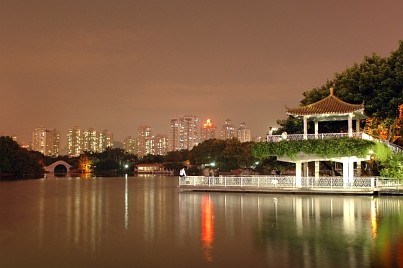 While the modern city is only three decades old, the region boasts a few worthwhile historical sites that date to the days of the Ming Dynasty. Visitors are often surprised to find more than theme parks and skyscrapers.
While the modern city is only three decades old, the region boasts a few worthwhile historical sites that date to the days of the Ming Dynasty. Visitors are often surprised to find more than theme parks and skyscrapers.The hilly countryside is dotted with fortified ruins, well-preserved temples and ancient tombs. Many of these are far enough removed from the central hotel districts that tourists will want to charter a ride with a minivan or taxi service. Hotel desks can help with these arrangements.
Otherwise, there are plenty of more cosmopolitan sites in the city. The skyline is headlined by Diwang Tower with its high-flying lookout deck. Several museums and cultural institutes are also here.
One of the top-10 biggest buildings in China, Diwang Building is a steely skyscraper that attracts a fair amount of tourists. The highlight is taking the elevator to the observation deck where views of Hong Kong's distant skyline are visible on clear days.
These beautiful outdoor gardens are accessible by public bus or taxi. This is a great place to escape the city for a couple of hours. The entire complex spans several acres of outlying foothills featuring teahouses, pavilions, waterfalls and a pagoda. The highlight is Hong Fa Temple.
Considered the second-best art museum in China, He Xiang Ning Art Museum boasts a world-class collection of modern art. The museum is named after the widow of a KMT (Chinese Nationalist) leader from the early 20th century.
Shenzhen isn't known for its temples, but there are a few worth exploring in the area. Aside from Hong Fa Temple in the botanical gardens, there's also the 15th-century Tianhou Temple in Chiwen (western Shenzhen). To the north of Chiwen are Dragon King and Phoenix Mountain temples. Also of historic interest, these two are easily visited as a pair.
The Hakka are an ethnic group from northern China who, after generations of migration, wall themselves into communal villages in the south. The village at Crane Lake has been partially restored and offers interesting insight into Hakka life in the 19th century.
This Ming Dynasty fortress dates to the late 14th century and has been well preserved. In the early 20th century, it was central to the British instigation of the Opium War. It's located 35 miles outside of town and is best seen via taxi or minivan.
In nearby Chiwan, the Royal Tomb is another historic site that visitors must charter transportation to visit. It's the tomb of a 13th-century ‘boy emperor', the last of the Southern Song Dynasty, who was thrown into the sea (in the arms of a royal official) to avoid capture by the Mongols.
Also called Xinan Old Town, this district was an administrative seat for the Ming Dynasty. More than 3,000 artifacts excavated from local digs have been moved to the local museum. The city dates to the 4th century, though most of what remains appeared more recently.
Find more information about Shenzhen and hotels in the area:
Shenzhen hotels | China hotels